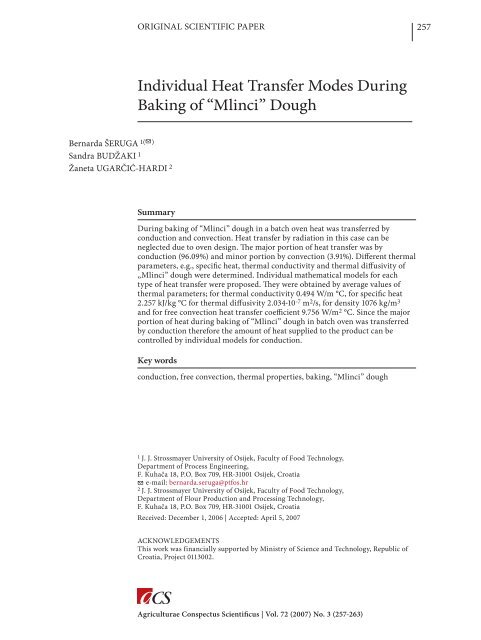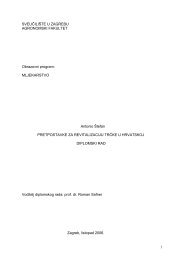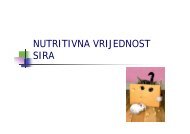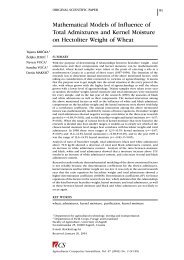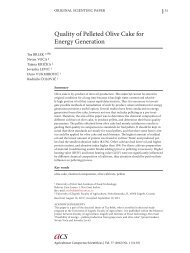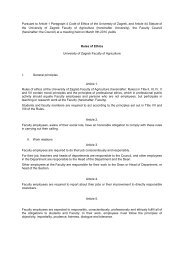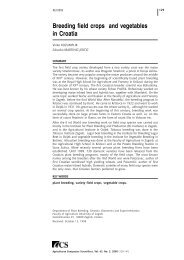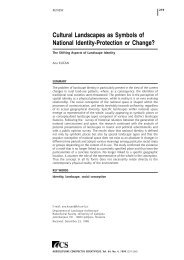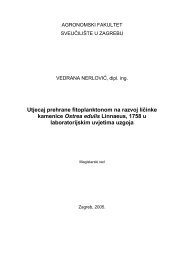Individual Heat Transfer Modes During Baking of “Mlinci” Dough
Individual Heat Transfer Modes During Baking of “Mlinci” Dough
Individual Heat Transfer Modes During Baking of “Mlinci” Dough
Create successful ePaper yourself
Turn your PDF publications into a flip-book with our unique Google optimized e-Paper software.
ORIGINAL SCIENTIFIC PAPER<br />
257<br />
<strong>Individual</strong> <strong>Heat</strong> <strong>Transfer</strong> <strong>Modes</strong> <strong>During</strong><br />
<strong>Baking</strong> <strong>of</strong> <strong>“Mlinci”</strong> <strong>Dough</strong><br />
Bernarda ŠERUGA 1( )<br />
Sandra BUDŽAKI 1<br />
Žaneta UGARČIĆ-HARDI 2<br />
Summary<br />
<strong>During</strong> baking <strong>of</strong> <strong>“Mlinci”</strong> dough in a batch oven heat was transferred by<br />
conduction and convection. <strong>Heat</strong> transfer by radiation in this case can be<br />
neglected due to oven design. The major portion <strong>of</strong> heat transfer was by<br />
conduction (96.09%) and minor portion by convection (3.91%). Different thermal<br />
parameters, e.g., specific heat, thermal conductivity and thermal diffusivity <strong>of</strong><br />
„Mlinci” dough were determined. <strong>Individual</strong> mathematical models for each<br />
type <strong>of</strong> heat transfer were proposed. They were obtained by average values <strong>of</strong><br />
thermal parameters; for thermal conductivity 0.494 W/m °C, for specific heat<br />
2.257 kJ/kg °C for thermal diffusivity 2.034·10 -7 m 2 /s, for density 1076 kg/m 3<br />
and for free convection heat transfer coefficient 9.756 W/m 2 °C. Since the major<br />
portion <strong>of</strong> heat during baking <strong>of</strong> <strong>“Mlinci”</strong> dough in batch oven was transferred<br />
by conduction therefore the amount <strong>of</strong> heat supplied to the product can be<br />
controlled by individual models for conduction.<br />
Key words<br />
conduction, free convection, thermal properties, baking, <strong>“Mlinci”</strong> dough<br />
1 J. J. Strossmayer University <strong>of</strong> Osijek, Faculty <strong>of</strong> Food Technology,<br />
Department <strong>of</strong> Process Engineering,<br />
F. Kuhača 18, P.O. Box 709, HR-31001 Osijek, Croatia<br />
e-mail: bernarda.seruga@ptfos.hr<br />
2 J. J. Strossmayer University <strong>of</strong> Osijek, Faculty <strong>of</strong> Food Technology,<br />
Department <strong>of</strong> Flour Production and Processing Technology,<br />
F. Kuhača 18, P.O. Box 709, HR-31001 Osijek, Croatia<br />
Received: December 1, 2006 | Accepted: April 5, 2007<br />
ACKNOWLEDGEMENTS<br />
This work was financially supported by Ministry <strong>of</strong> Science and Technology, Republic <strong>of</strong><br />
Croatia, Project 0113002.<br />
Agriculturae Conspectus Scientificus | Vol. 72 (2007) No. 3 (257-263)
258 Bernarda ŠERUGA, Sandra BUDŽAKI, Žaneta UGARČIĆ-HARDI<br />
Introduction<br />
Croatian unleavened flat bread <strong>“Mlinci”</strong> is a type <strong>of</strong> flat<br />
bread produced from wheat flour, water and salt. <strong>Dough</strong> is<br />
prepared as for chapati (Indian flat bread) and baked on a<br />
hot plate for a few minutes. Baked <strong>“Mlinci”</strong> can be stored<br />
for several months. <strong>“Mlinci”</strong> are different from chapati,<br />
and their final treatment includes cooking in water for approximately<br />
1–2 min. <strong>“Mlinci”</strong> is a traditional Croatian<br />
dish, consumed as a side dish with baked turkey. To design<br />
a continuous baking and puffing oven for <strong>“Mlinci”</strong>, it is<br />
necessary to know the energy requirement in the system.<br />
The thermal conductivity, specific heat and thermal diffusivity<br />
<strong>of</strong> dough are important physical properties needed<br />
in the analysis <strong>of</strong> the heat transfer during the processing.<br />
Thermal conductivity <strong>of</strong> food is an important property<br />
used in calculations involving rate <strong>of</strong> heat transfer. In<br />
quantitative terms, this property gives the amount <strong>of</strong> heat<br />
that will be conducted per unit <strong>of</strong> time through the unit<br />
<strong>of</strong> thickness <strong>of</strong> the material if a unit temperature gradient<br />
exists across that thickness. Specific heat is a quantity <strong>of</strong><br />
heat that is gained or lost by unit mass <strong>of</strong> product to accomplish<br />
a unit change in temperature, without a change<br />
in state. Specific heat is an essential part <strong>of</strong> the thermal<br />
analysis <strong>of</strong> food processing or <strong>of</strong> the equipment used in<br />
heating or cooling <strong>of</strong> foods. In designing food processes and<br />
processing equipment, we need numerical values for the<br />
specific heat <strong>of</strong> the food and materials to be used. Thermal<br />
diffusivity is a ratio involving thermal conductivity, density,<br />
and specific heat. There are two ways to obtain such<br />
values. Published data are available that provide values <strong>of</strong><br />
thermal conductivity and specific heat for some food and<br />
non-food materials. Another way to obtain those values is<br />
to use a predictive equation. Predictive equations are empirical<br />
expressions, obtained by fitting experimental data<br />
into mathematical models.<br />
Up to now, many researchers have measured the thermal<br />
properties <strong>of</strong> foods applying various measurement<br />
techniques that can be found in the literature. Some comprehensive<br />
reviews have also been published. However, the<br />
information regarding the thermo-physical properties <strong>of</strong><br />
dough and bakery products during baking is scarce when<br />
compared with other products. Choi and Okos (1985) established<br />
the general mathematical models to predict the<br />
thermal properties <strong>of</strong> food products. It was developed on<br />
the basis <strong>of</strong> the thermal properties <strong>of</strong> each pure component<br />
and its weight fraction that was an easily measurable<br />
factor compared to the volume fraction. These mathematical<br />
models were established for the temperature range<br />
from 40°C to 150°C. Kulacki and Kennedy (1978) reported<br />
the results <strong>of</strong> an experimental study on the thermal conductivity,<br />
specific heat, density and thermal diffusivity <strong>of</strong><br />
two different types <strong>of</strong> standard dough: AACC and hardsweet<br />
(HS) formula. In the present experiments, a single<br />
plate thermal conductivity apparatus was used. Thermal<br />
conductivity was determined in the temperature interval<br />
from 24.35°C to 64.15°C. The specific heat measurement<br />
was based on the method <strong>of</strong> mixture in temperature range<br />
from 29.65 °C to 38.85 °C. The density <strong>of</strong> both dough types<br />
was determined by weighing a known volume <strong>of</strong> dough.<br />
All <strong>of</strong> the density determinations were made at 25°C. The<br />
thermal diffusivity <strong>of</strong> dough types was evaluated using<br />
the thermal conductivity and specific heat data presented<br />
in the paper. In the work <strong>of</strong> Hwang and Hayakawa (1979)<br />
the instrument for determination <strong>of</strong> the specific heat <strong>of</strong><br />
cookies, wheat flour and fresh produce was described.<br />
Gupta (1990, 1993) determined the specific heat and thermal<br />
conductivity <strong>of</strong> Indian unleavened flat bread (chapatti).<br />
El-Bushra (2001) presented the construction <strong>of</strong> an<br />
isoperbol calorimeter to measure the specific heat capacity<br />
<strong>of</strong> foods. The instrument was tested with five dough<br />
types. Baik et al. (2001) discussed both the common and<br />
the new measurement techniques, prediction models, and<br />
published data on thermo-physical properties <strong>of</strong> bakery<br />
products: specific heat, thermal conductivity, thermal diffusivity,<br />
and density.<br />
The aim <strong>of</strong> the work reported in this paper was to determine<br />
the individual heat transfer modes during contact<br />
baking <strong>of</strong> <strong>“Mlinci”</strong> dough in batch oven. These heat<br />
transfer modes will be useful for determination <strong>of</strong> heat requirement<br />
for designing the continuous oven. Calculation<br />
<strong>of</strong> these heat transfer modes are given in Appendix A. The<br />
transfer <strong>of</strong> heat in the oven by each individual mode can be<br />
expressed in terms <strong>of</strong> temperature driving force, transfer<br />
area and heat transfer coefficient, assuming steady state<br />
heat transfer.<br />
Material and methods<br />
The measurements were performed with the basic<br />
<strong>“Mlinci”</strong> dough T-500 (Table 1). <strong>“Mlinci”</strong> dough T-500 samples<br />
were prepared in the industrial laboratory Đakovština<br />
food industry and cereals trade P.C. Tena, Đakovo, Croatia.<br />
The samples <strong>of</strong> <strong>“Mlinci”</strong> dough T-500 were prepared by<br />
mixing flour T-500 with water and kneading the mixture<br />
in a low batch mixer for 15 min. After resting <strong>of</strong> 15–20 min,<br />
the dough was divided, rounded and flattened in the rolling<br />
machine (Roll-fix) to a flat cake with a length <strong>of</strong> 245<br />
mm, width 140 mm and a thickness <strong>of</strong> 1 mm.<br />
Thermal conductivity was determined by means <strong>of</strong><br />
the apparatus TC-1 that represents a modification <strong>of</strong> the<br />
guarded hot plate steady state method as described in<br />
ASTM Standard C 177-76 (ANONYM 1976) for dough.<br />
This is a single-plate thermal conductivity apparatus with<br />
the adaptability to different specimen thickness (3–10 mm)<br />
and various homogeneous food materials. The temperature<br />
was measured with Pt 100 thermocouples. The apparatus<br />
Agric. conspec. sci. Vol. 72 (2007) No. 3
<strong>Individual</strong> <strong>Heat</strong> <strong>Transfer</strong> <strong>Modes</strong> <strong>During</strong> <strong>Baking</strong> <strong>of</strong> <strong>“Mlinci”</strong> <strong>Dough</strong><br />
259<br />
Table 1. The composition <strong>of</strong> <strong>“Mlinci”</strong> dough T-500<br />
Ingredient<br />
Weight (kg)<br />
Flour T-500 1<br />
Salt 0.0053<br />
Antischim 0.0053<br />
Vinegar 0.0134<br />
Water 0.46<br />
Total 1.5<br />
and measurements system for on-line data, the s<strong>of</strong>tware<br />
for the control <strong>of</strong> the process, and the statistical evaluation<br />
<strong>of</strong> thermal conductivity were constructed and/or developed<br />
at the Faculty <strong>of</strong> Food Technology and Faculty<br />
<strong>of</strong> Electrical Engineering, University J. J.Strossmayer <strong>of</strong><br />
Osijek, Croatia<br />
The sample the density <strong>of</strong> which has been determined<br />
previously, was placed between the heated and the cooled<br />
plates and the steady state heat flux and temperature difference<br />
across the sample were measured. After a certain<br />
period <strong>of</strong> time, depending on the characteristics <strong>of</strong> the<br />
sample, the temperatures <strong>of</strong> the heated and cooled surfaces<br />
<strong>of</strong> the sample and the final water temperature for the accumulation<br />
<strong>of</strong> energy became constant, indicating that the<br />
steady state was reached. All results <strong>of</strong> the measurements<br />
were stored in the computer and used in the calculations<br />
<strong>of</strong> thermal conductivity. The experiments were repeated<br />
at least five times. According to Fourier’s law <strong>of</strong> undirectional<br />
conduction steady state rate heat flow trought the<br />
sample is:<br />
k A<br />
T<br />
q [W] (1)<br />
x<br />
The heat transferred through the sample heats the water<br />
in time Δt. Thus, total heat is:<br />
p<br />
<br />
Q W C<br />
T T<br />
[J]<br />
f<br />
i<br />
<br />
or<br />
Q W C<br />
p<br />
T<br />
f<br />
Ti<br />
<br />
q <br />
[W] (2)<br />
t<br />
t<br />
Equating (1) and (2), ignoring the heat loss at the steady<br />
state and rearranging:<br />
<br />
<br />
W C<br />
p<br />
T<br />
f<br />
Ti<br />
x<br />
k <br />
A<br />
T<br />
t<br />
[W/m °C] (3)<br />
Where is<br />
k Thermal conductivity <strong>of</strong> sample (W/m °C)<br />
W Mass <strong>of</strong> water for the accumulation <strong>of</strong> energy (kg)<br />
C p Specific thermal capacity <strong>of</strong> water (J/kg °C)<br />
T f Final temperature <strong>of</strong> water for the accumulation <strong>of</strong><br />
energy (°C)<br />
T i Initial temperature <strong>of</strong> water for the accumulation <strong>of</strong><br />
energy (°C)<br />
Δx Thickness <strong>of</strong> sample (m)<br />
A Area surface <strong>of</strong> sample (m 2 )<br />
ΔT Temperature difference between the heated and the<br />
cooled surfaces (°C)<br />
Δt Time for reaching the steady state (s)<br />
The specific heat <strong>of</strong> <strong>“Mlinci”</strong> dough was determined by<br />
a modified method <strong>of</strong> mixture. It is referred to as modified<br />
because there was no direct contact between sample<br />
(<strong>“Mlinci”</strong> dough) and heat exchange medium (water). The<br />
method consisted <strong>of</strong> filling the sample in the polyethylene<br />
pouch and immersing it in the water at a different<br />
temperature. <strong>During</strong> the experiment a shaker rotated the<br />
calorimeter. The copper-constantan thermocouple types<br />
T diameter 0.025 cm (Cole-Parmer, International, U.S.A.)<br />
was used to record temperature. Data from the four thermocouples<br />
were recorded every minute with data acquisition<br />
s<strong>of</strong>tware and hardware, PicoLog Recorder and PicoLog<br />
Player, interfered to PC at 80 MHz. The apparatus and<br />
measurements system for on-line data, the s<strong>of</strong>tware for the<br />
control <strong>of</strong> the process, and the statistical evaluation <strong>of</strong> specific<br />
heat were constructed and/or developed at the Faculty<br />
<strong>of</strong> Food Technology and Faculty <strong>of</strong> Electrical Engineering,<br />
University J. J.Strossmayer <strong>of</strong> Osijek, Croatia.<br />
The heat capacity <strong>of</strong> the calorimeter, H k , that was defined<br />
as the heat required for raising the temperature <strong>of</strong> a<br />
calorimeter by 1 °C, was needed as a correction factor for<br />
specific heat determination <strong>of</strong> sample. The H k was determined<br />
as follows:<br />
dT <br />
C<br />
pw<br />
M<br />
w<br />
Te<br />
Tiw<br />
te<br />
dt<br />
<br />
H<br />
<br />
k<br />
<br />
<br />
[J/°C] (4)<br />
dT <br />
Tik<br />
Te<br />
te<br />
dt <br />
Where is<br />
H k <strong>Heat</strong> capacity <strong>of</strong> calorimeter (J/°C)<br />
C pw Specific heat capacity <strong>of</strong> water (J/kg °C)<br />
M w Mass <strong>of</strong> water (kg)<br />
T e Temperature <strong>of</strong> equilibrium state (°C)<br />
T iw Water temperature at initial state (°C)<br />
T ik Temperature <strong>of</strong> calorimeter in initial state (°C)<br />
t e Time <strong>of</strong> equilibrium state (min)<br />
dT <br />
The term <br />
dt was calculated from the slope from<br />
<br />
the plot temperature vs. time for calorimeter experimental<br />
data. After a certain time (20-30 min) which depends<br />
upon the characteristic <strong>of</strong> the material, equilibrium tem-<br />
Agric. conspec. sci. Vol. 72 (2007) No. 3
260 Bernarda ŠERUGA, Sandra BUDŽAKI, Žaneta UGARČIĆ-HARDI<br />
perature was reached i.e., the temperatures <strong>of</strong> water inside<br />
the beaker, between the beaker and insulation and inside<br />
the polyethylene pouch became equal. This time represents<br />
the time <strong>of</strong> equilibrium state, t e , which was determined<br />
experimentally. From these data heat capacity <strong>of</strong><br />
the calorimeter was calculated.<br />
From the law <strong>of</strong> energy conservation, i.e., the total heat<br />
in the beginning <strong>of</strong> the system is equal to the final heat <strong>of</strong><br />
the system plus the heat lost to the environment, the following<br />
equation can be derived:<br />
C<br />
B <br />
T<br />
<br />
T<br />
T<br />
<br />
<br />
fw iw R<br />
ps<br />
[J/kg °C]<br />
M<br />
s<br />
TR<br />
T<br />
fs<br />
Tis<br />
B<br />
C<br />
ps<br />
M<br />
w<br />
H<br />
<br />
dT <br />
TR<br />
te<br />
<br />
dt <br />
where is<br />
C ps Specific heat capacity <strong>of</strong> sample (J/kg °C)<br />
T fw Water temperature at final state (°C)<br />
T fs Temperature <strong>of</strong> sample at final state (°C)<br />
T is Temperature <strong>of</strong> sample at initial state (°C)<br />
M s Mass <strong>of</strong> sample (kg)<br />
k<br />
<br />
<br />
<br />
<br />
dT <br />
The term <br />
dt <br />
was calculated from slope from the plot<br />
temperature vs. time for sample and equilibrium time from<br />
equilibrium state also for sample.<br />
The density <strong>of</strong> dough was determined by weighing a<br />
known volume <strong>of</strong> the dough.<br />
The thermal diffusivity was obtained from following<br />
equation:<br />
k<br />
[m 2 /s] (6)<br />
c p<br />
where is<br />
α Thermal diffusivity (m 2 /s)<br />
k Thermal conductivity coefficient (W/m °C)<br />
ρ Density (kg/m 3 )<br />
c p Specific heat capacity (J/kg °C)<br />
The baking oven for batch baking <strong>of</strong> <strong>“Mlinci”</strong> dough is<br />
like tunnel without upper wall. Instead <strong>of</strong> upper wall there<br />
are crossbars at the 1.5 m from the hot surface. <strong>“Mlinci”</strong><br />
dough was put on hot surface to bake, each side for 5.5<br />
min. After baking they cross over to upper crossbars to<br />
dry for 15 min. Finally, <strong>“Mlinci”</strong> dough were cooled and<br />
packed.<br />
The measurements <strong>of</strong> temperature inside the oven (hot<br />
surface and hot air) and on the <strong>“Mlinci”</strong> dough surface<br />
were conducted with surface thermocouple type K (-60°C<br />
(5)<br />
to 300°C) with device TESTO 635 (Testo) with accuracy<br />
<strong>of</strong> ± 1°C. The surface temperature <strong>of</strong> "Mlinci" dough was<br />
measured at an interval <strong>of</strong> 26 min by putting smoothly the<br />
thermocouple on the surface <strong>of</strong> "Mlinci" dough, in such a<br />
way that it does not damage the "Mlinci" dough.<br />
<strong>During</strong> baking <strong>of</strong> "Mlinci" dough in batch oven, heat<br />
is mainly transferred:<br />
1. By conduction to the bottom <strong>of</strong> the "Mlinci" dough<br />
surface which is in contact with hot surface.<br />
2. Partly by radiation to the surface <strong>of</strong> the "Mlinci"<br />
dough exposed to air.<br />
3. By free convection to the exposed surface <strong>of</strong> the<br />
"Mlinci" dough.<br />
The heat transfer between media (hot surface) and the<br />
product ("Mlinci" dough) takes place by conduction:<br />
<br />
<br />
k AM<br />
Th<br />
Ti<br />
qc<br />
[W] (7)<br />
x<br />
where is<br />
k Thermal conductivity <strong>of</strong> <strong>“Mlinci”</strong> dough (W/m °C)<br />
A M Area <strong>of</strong> <strong>“Mlinci”</strong> dough in contact with hating medium<br />
(hot surface) (m 2 )<br />
T h Temperature <strong>of</strong> hot side <strong>of</strong> <strong>“Mlinci”</strong> dough in contact<br />
with hot surface (°C)<br />
T i Initial temperature <strong>of</strong> <strong>“Mlinci”</strong> dough (°C)<br />
x Thickness <strong>of</strong> <strong>“Mlinci”</strong> dough (m)<br />
The heat transferred by radiation during baking <strong>of</strong><br />
<strong>“Mlinci”</strong> dough in batch oven can be neglected due to the<br />
construction <strong>of</strong> the oven. As mentioned above, the oven for<br />
batch baking the <strong>“Mlinci”</strong> dough is without upper cover.<br />
The heat transfer between air and <strong>“Mlinci”</strong> dough takes<br />
place by free convection.<br />
<br />
<br />
q<br />
fc<br />
h<br />
fc<br />
AM<br />
Ta<br />
TM<br />
[W] (8)<br />
where is<br />
h fc <strong>Heat</strong> transfer coefficient for free convection<br />
(W/m 2 °C)<br />
T a Temperature <strong>of</strong> hot air (°C)<br />
T M Temperature <strong>of</strong> <strong>“Mlinci”</strong> dough surface exposed to air<br />
(°C)<br />
Various parameters required for calculating individual<br />
heat transfer modes are presented in Table 2.<br />
Results and discussion<br />
For the data analysis, the Standard Practice for Statistical<br />
Treatment <strong>of</strong> Thermoanalytical Data (Anonym, 2000) was<br />
used.<br />
The average value <strong>of</strong> thermal conductivity and specific<br />
heat capacity was 0.494 W/m °C and 2257 J/kg °C respectively<br />
as reported in Table 1 for thermal diffusivity <strong>of</strong> <strong>“Mlinci”</strong><br />
dough <strong>of</strong> 2.034·10 -7 m 2 /s and density <strong>of</strong> 1076 kg/m 3 .<br />
Agric. conspec. sci. Vol. 72 (2007) No. 3
<strong>Individual</strong> <strong>Heat</strong> <strong>Transfer</strong> <strong>Modes</strong> <strong>During</strong> <strong>Baking</strong> <strong>of</strong> <strong>“Mlinci”</strong> <strong>Dough</strong><br />
261<br />
Theoretically, total heat transferred to <strong>“Mlinci”</strong> dough<br />
must be equal to the total heat absorbed by <strong>“Mlinci”</strong> dough.<br />
<strong>Heat</strong> transferred to <strong>“Mlinci”</strong> dough is equal to q t =q c +q fc<br />
and heat absorbed by <strong>“Mlinci”</strong> dough is equal to q a =q s +q l .<br />
The sensible heat is given as:<br />
<br />
<br />
W c<br />
p<br />
Th<br />
Ti<br />
qs<br />
<br />
t<br />
[W] (9)<br />
where is<br />
W Weight <strong>of</strong> <strong>“Mlinci”</strong> dough (kg)<br />
C p Specific heat capacity <strong>of</strong> <strong>“Mlinci”</strong> dough (J/kg °C)<br />
Δt Elapsed time (s)<br />
The latent heat is given as:<br />
H<br />
vap<br />
M<br />
ql<br />
[W] (10)<br />
t<br />
where is<br />
H vap Latent heat <strong>of</strong> vaporization <strong>of</strong> water (2256.97 kJ/kg)<br />
ΔM Moisture mass loss <strong>of</strong> <strong>“Mlinci”</strong> dough during baking<br />
(kg)<br />
The moisture loss was calculated from the initial moisture<br />
content <strong>of</strong> formed <strong>“Mlinci”</strong> dough and final moisture<br />
content <strong>of</strong> baked <strong>“Mlinci”</strong> dough (wet basis). Time taken<br />
for baking <strong>of</strong> <strong>“Mlinci”</strong> dough was also noted. All these<br />
data are presented in Table 2.<br />
In the present study, the heat absorbed by <strong>“Mlinci”</strong><br />
dough (293.86 W) and heat transferred to <strong>“Mlinci”</strong> dough<br />
(299.76 W) are in good agreement. The complete heat balance<br />
for baking <strong>of</strong> <strong>“Mlinci”</strong> dough in batch oven (transfer<br />
to a single <strong>“Mlinci”</strong> dough) is presented in Table 3.<br />
The deviation <strong>of</strong> 1.9% is attributed to the heat <strong>of</strong> radiation,<br />
heat <strong>of</strong> fusion <strong>of</strong> fats, heat <strong>of</strong> reaction, heat <strong>of</strong> solution<br />
and heat <strong>of</strong> vaporization <strong>of</strong> volatile, which have been<br />
neglected (Gupta, 2001). The contribution <strong>of</strong> heat transferred<br />
by conduction was 96.09% and heat transferred by<br />
free convection was 3.91%. To calculate the transferred<br />
heat by convection, free convection heat transfer coefficient<br />
was obtained using the Nusselt number.<br />
<br />
<br />
Nu Gr,<br />
Pr<br />
Nu a Gr Pr<br />
<br />
m<br />
(11)<br />
h L<br />
Nu (12)<br />
k<br />
From equation (12) the free convection heat transfer coefficient<br />
can be calculated using the following equation:<br />
h fc<br />
fc<br />
<br />
k<br />
Nu <br />
(13)<br />
L<br />
Table 2. Various parameters required for obtaining<br />
individual heat transfer modes<br />
1 The average specific heat <strong>of</strong> "Mlinci" dough 2.257 kJ/kg °C<br />
2 The average thermal conductivity <strong>of</strong> 0.494 W/m °C<br />
"Mlinci" dough<br />
3 Initial moisture content in "Mlinci" dough 30%<br />
(wet basis)<br />
4 Final moisture content in "Mlinci" dough 14%<br />
(wet basis)<br />
5 Weight <strong>of</strong> "Mlinci" dough 0.36907 kg<br />
6 Temperature <strong>of</strong> heating medium (hot 195.5 °C<br />
surface)<br />
7 Air temperature in the oven 70 °C<br />
8 Temperature <strong>of</strong> "Mlinci" dough surface in 52 °C<br />
contact with hot surface<br />
9 Initial temperature <strong>of</strong> "Mlinci" dough 35 °C<br />
10 Linear dimension <strong>of</strong> "Mlinci" dough 0.1925 m<br />
11 Area <strong>of</strong> "Mlinci" dough 0.0343 m 2<br />
12 Thickness <strong>of</strong> "Mlinci" dough 0.001 m<br />
13 <strong>Baking</strong> time 1560 s<br />
14 Moisture removed from "Mlinci" dough 0.19684 kg<br />
15 <strong>Heat</strong> transfer coefficient for free convection 9.756 W/m 2 °C<br />
16 Thermal diffusivity <strong>of</strong> "Mlinci" dough 2.034·10 -7 m 2 /s<br />
17 Density <strong>of</strong> "Mlinci" dough 1076 kg/m 3<br />
Table 3. Complete heat balance for baking <strong>of</strong> <strong>“Mlinci”</strong><br />
dough in batch oven (heat transfer to a single <strong>“Mlinci”</strong> dough)<br />
Contribution (W) % <strong>of</strong> total heat<br />
Total heat absorbed per 239.86 100<br />
"Mlinci" dough, qa<br />
As sensible heat, qs 9.08 3.09<br />
As latent heat, ql 284.78 96.91<br />
Total heat transferred per 299.76 100<br />
"Mlinci" dough, qt<br />
By conduction, qc 288.05 96.09<br />
By convection, qfc 11.71 3.91<br />
where is<br />
Nu Nusselt number<br />
Gr Grash<strong>of</strong> number<br />
Pr Prandtl number<br />
k Thermal conductivity for air at average temperature<br />
<strong>of</strong> film (W/m °C)<br />
L Linear dimension <strong>of</strong> <strong>“Mlinci”</strong> dough (m)<br />
The value <strong>of</strong> h fc was calculated from Eq. (13) and substituted<br />
in Eq. (8) to obtain free convection, q fc . The values<br />
are presented in Table 3. The parameters a and m from Eq.<br />
(11) were determined using literature. For (Gr . Pr) equal<br />
to 10 3 , the heat transferred is approximately equal to that<br />
Agric. conspec. sci. Vol. 72 (2007) No. 3
262 Bernarda ŠERUGA, Sandra BUDŽAKI, Žaneta UGARČIĆ-HARDI<br />
T h<br />
T M<br />
T a<br />
"MLINCI"<br />
HOT<br />
SURFACE,<br />
T=195.5 °C<br />
Figure 1.<br />
<strong>“Mlinci”</strong> dough in<br />
contact with hot<br />
surface in batch oven<br />
HEAT TRANSFER<br />
GAS BURNER<br />
due to conduction alone, but for (Gr . Pr) from 10 4 to 10 6 ,<br />
the heat transferred is given by Nu=0.15.(Gr . Pr) 0.25 . For<br />
high values <strong>of</strong> (Gr . Pr), Nu is proportional to (Gr . Pr) 1/3 ,<br />
showing that the heat is transferred not entirely by convection<br />
and is not influenced by distance between the surfaces<br />
(Coulson et al., 1980). For baking <strong>of</strong> <strong>“Mlinci”</strong> dough<br />
in batch oven the free convection heat transfer coefficient<br />
was obtained using the following equation:<br />
1/ 3 k<br />
h 0 .14 Gr<br />
Pr<br />
<br />
(14)<br />
L<br />
Figure 1 is shows course <strong>of</strong> heat transfer during baking<br />
<strong>of</strong> <strong>“Mlinci”</strong> dough and position <strong>of</strong> <strong>“Mlinci”</strong> dough placed<br />
on hot surface that is situated above heat source. For horizontal<br />
plates facing heated surface up where the (Gr . Pr) is<br />
from 2⋅10 7 to 3⋅10 10 the parameters are a=0.14 and m=1/3<br />
(Pitts and Sissom, 1977).<br />
Total heat absorbed by <strong>“Mlinci”</strong> dough, which comprised<br />
<strong>of</strong> sensible and latent heat was calculated. The contribution<br />
<strong>of</strong> latent heat (284.78 W) was about 93% more than<br />
the sensible heat (9.08 W) because large amount <strong>of</strong> heat is<br />
required for baking <strong>of</strong> <strong>“Mlinci”</strong> dough as inside moisture<br />
has to be converted from liquid phase to vapour phase.<br />
The <strong>“Mlinci”</strong> dough is declared as a long lasting product<br />
due to amount <strong>of</strong> final moisture content (14%).<br />
Conclusions<br />
<strong>During</strong> baking <strong>of</strong> <strong>“Mlinci”</strong> dough in batch oven combination<br />
<strong>of</strong> different heat transfer modes occurs. <strong>Heat</strong> was<br />
transferred by conduction and convection. The heat transfer<br />
by radiation was neglected due to oven design. The<br />
major contribution is due to conduction, 96.09%. Thus, it<br />
is required to control the amount <strong>of</strong> heat supplied to the<br />
product by the individual modes, particularly by conduction.<br />
The obtained heat transfer modes and thermal parameters<br />
can be used for designing the continuous oven<br />
for baking <strong>“Mlinci”</strong> dough.<br />
Appendix A<br />
Calculation <strong>of</strong> individual heat transfer modes<br />
(i) By conduction<br />
k AM<br />
T<br />
h<br />
Ti<br />
<br />
qc<br />
<br />
x<br />
0.494<br />
0.0343<br />
52<br />
35<br />
qc<br />
<br />
0.001<br />
(ii) By free convection<br />
q<br />
h<br />
h<br />
h<br />
q<br />
q<br />
fc<br />
fc<br />
fc<br />
fc<br />
fc<br />
fc<br />
h<br />
fc<br />
A<br />
M<br />
<br />
T<br />
T<br />
1/ 3 k<br />
0.14 Gr<br />
Pr<br />
<br />
L<br />
8 0.33 0.027375<br />
0.14 1.42<br />
10<br />
<br />
0.1925<br />
2<br />
9.745 W/m C<br />
9.756 0.0343<br />
70 35<br />
11.71 W<br />
a<br />
<br />
M<br />
<br />
The total heat transferred to single <strong>“Mlinci”</strong> dough is<br />
equal to heat transferred by conduction and by free convection<br />
(neglecting heat transferred by radiation)<br />
qt<br />
qc<br />
q<br />
fc<br />
qt<br />
288.05 11.71<br />
q 299.76 W<br />
t<br />
The total heat absorbed by the product is calculated,<br />
from the rise in temperature <strong>of</strong> the product and latent<br />
heat <strong>of</strong> vaporization <strong>of</strong> moisture (neglecting heat <strong>of</strong> reaction<br />
etc.), i.e.,<br />
<br />
Agric. conspec. sci. Vol. 72 (2007) No. 3
<strong>Individual</strong> <strong>Heat</strong> <strong>Transfer</strong> <strong>Modes</strong> <strong>During</strong> <strong>Baking</strong> <strong>of</strong> <strong>“Mlinci”</strong> <strong>Dough</strong><br />
263<br />
q<br />
q<br />
q<br />
q<br />
a<br />
a<br />
a<br />
a<br />
q<br />
s<br />
q<br />
l<br />
<br />
<br />
W c<br />
p<br />
Th<br />
Ti<br />
H<br />
vap<br />
M<br />
<br />
<br />
t<br />
t<br />
3<br />
0.36907 2257 52<br />
35<br />
2256.97 10<br />
0.19684<br />
<br />
<br />
1560<br />
1560<br />
293.86 W<br />
It takes 26 min for baking the <strong>“Mlinci”</strong> dough in batch<br />
oven or 1560 s and the moisture removal is 196.84 g during<br />
this period.<br />
References<br />
Anonym. (1976): Guarded hot plate apparatus. Standard C<br />
177-76 Annual American Society for Testing and Materials,<br />
Standards, Part 18<br />
Anonym. (2000): Standard Practice for Statistical Treatment <strong>of</strong><br />
Thermoanalytical Data, Annual American Society for Testing<br />
and Materials, Standards, 14.02.: 828–830<br />
Baik O.D., Marcotte M., Sablani S.S., Castaigne F. (2001): Thermal<br />
and Physical Properties <strong>of</strong> Bakery Products, Critical Reviews<br />
in Food Science and Nutrition 41: 321–352<br />
Choi Y., Okos M. (1985): Effects <strong>of</strong> temperature and composition<br />
on the thermal properties <strong>of</strong> foods. In: Proceedings <strong>of</strong> the<br />
Fourth International Congress on Engineering and Food,<br />
Etnisnton, Alberta, Canada, 7–10<br />
Coulson J.M., Richardson J.F., Banckhurst J.R., Haker J.H. (1980):<br />
Chemical Engineering. Fluid flow, heat transfer and mass<br />
transfer, Pergamon Press, Oxford, England, 203-206<br />
El-Bushra S.E. (2001): Construction <strong>of</strong> an Isoperibol Calorimeter<br />
to Measure the heat Capacity <strong>of</strong> Foods Between 20 and 90 °C,<br />
Journal <strong>of</strong> Thermal Analysis and Calorimetry, 64: 261-272<br />
Gupta T.R. (1990): Specific <strong>Heat</strong> <strong>of</strong> Indian Unleavened Flat Bread<br />
(Chapatti) at Various Stages <strong>of</strong> Cooking, Journal <strong>of</strong> Food<br />
Process Engineering, 13: 217-227<br />
Gupta T.R. (1993): Thermal conductivity <strong>of</strong> Indian unleavened flat<br />
bread (Chapati) at various stages <strong>of</strong> baking, Journal <strong>of</strong> Food<br />
Process Engineering, 16: 227–235<br />
Gupta T.R. (2001): <strong>Individual</strong> heat transfer modes during<br />
contact baking <strong>of</strong> Indian unleavened flat bread (capati) in a<br />
continuous oven, Journal <strong>of</strong> Food Engineering, 47: 313-319<br />
Hwang M.P., Hayakawa Kan-Ichi. (1979): A specific heat<br />
calorimeter for foods, Journal <strong>of</strong> Food Science, 44: 435-438<br />
Kulacki F.A., Kennedy S.C. (1978): Measurement <strong>of</strong> the thermophysical<br />
properties <strong>of</strong> common cookie dough, Journal <strong>of</strong> Food<br />
Science, 43: 380–384<br />
Pitts D.R., Sissom L.E. (1977): Schaum’s outline <strong>of</strong> Theory and<br />
problems <strong>of</strong> heat transfer, McGraw-Hill, New York, 195-205<br />
acs72_42<br />
Agric. conspec. sci. Vol. 72 (2007) No. 3


